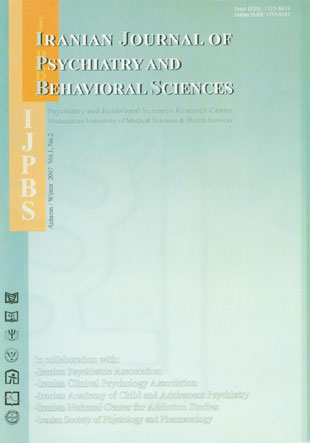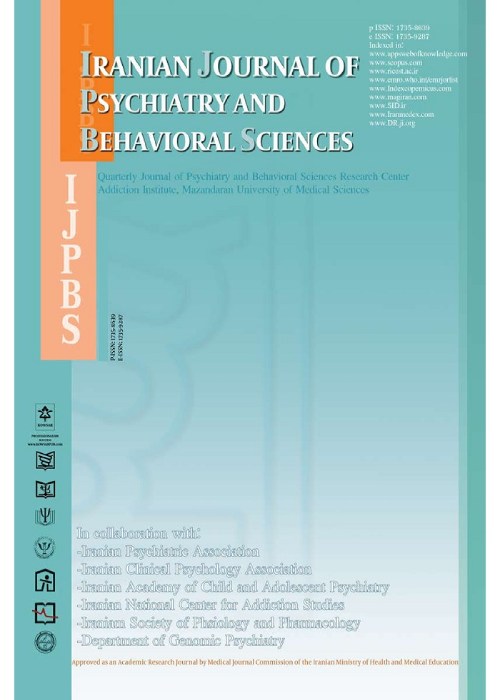فهرست مطالب

Iranian Journal of Psychiatry and Behavioral Sciences
Volume:1 Issue: 2, Jan 2007
- تاریخ انتشار: 1386/10/11
- تعداد عناوین: 13
-
-
Page 11Objective
Although in international studies, it has been reported to be the sixth most common method of suicide, self-Immolation is reported to be one of the most common methods of suicide in Iran. Considering the differences in epidemiological and psychiatric characteristics of suicide in different societies, we aimed to determine the psychological characteristics of those patients who attempted suicide by setting themselves on fire in Kermanshah in order to develop preventive measures against this tragic form of self harm.
MethodsIn a cross-sectional study in 2003, 227 in-patients of a burn unit in Kermanshah who had attempted suicide by self-immolation were screened out for mental illness. One hundred and ninety seven of them were subsequently assessed psychologically by using DSM-IV criteria.
ResultsEighty one and half percent of the patients were female with a mean age of 27.1. The majority of the patients were married and unemployed. Most of them were living in urban areas. Twenty one percent of the patients had a history of chronic physical illness and 59.9% a history of depression. Somatoform disorders were detected in 36.5% of the cases and substance misuse in 7.5%. There was a 17.6% past history of deliberate self-harm in the patients and 20% in the family members. Suicide by self-burning had been precipitated by marital conflicts in 33.9% of the cases and by family conflicts in 23.2%. There was a high rate of mortality among the patients (50.2%).
ConclusionAlthough most of the risk factors for suicide in our population were similar to what is already known in the literature, we found that married women in Kermanshah province were particularly at higher risk of killing themselves by the method of self immolation
-
Page 16ObjectiveGlutamate antagonists including anticonvulsant topiramate have been recommended for the pharmacological management of schizophrenia.MethodsA randomized, double-blind, placebo controlled clinical trial was performed on 32 patients diagnosed with schizophrenia (18-45 years old). Baseline information was gathered on demographic characteristics, vital signs, height, weight, smoking habit, (past) psychiatric history, drug history and adverse effects to medication. Patients were randomly assigned to topiramate group (n=16) or placebo one (n=16). Positive and negative syndrome scale (PANSS) was administered on each patient at baseline, on days 28 and 56.ResultsThe mean total PANSS score in topiramate group was 96.87 (85.37-108.37) at baseline, 85.68 (74.67-96.70) on day 28 and 76.87(66.06-87.69) on day 56. These were 101.87 (90.37-113.37), 100.31 (89.29-111.32) and 100.56 (89.74-111.37) respectively in placebo group. General linear model for repeated measure analysis showed that topiramate has lowered PANSS score significantly.ConclusionSignificant decline was also found in all three PANSS components (negative, positive and psychopathology symptoms). Topiramate can therefore be used as an effective add-on medication in treating schizophrenia.
-
Page 23ObjectiveTo manage a treatment resistant depression, clinicians may add a second medicationto the first antidepressant drug. The aim of the current research was to study the outcome of augmentation of citalopram with nortryptiline or triiodothyronine in a randomized clinical trial.MethodsWe selected 48 adult outpatients with a diagnosis of non-psychoticmajor depressive disorder who had not responded to 12 weeks citalopram therapy (40 mg perday). They were randomly allocated to two groups. One group received nortryiptiline (at a dose of upto 150 mg per day) and the other triiodothyronine (T3) (at a dose of up to 50 µg per day). The remission of depression was defined as a score of 7or less on the 17-item Hamilton Rating Scale for Depression(HRSD-17).ResultsAfter 8 weeks, the nortriptyline group had a higher remission rate (33.33 %) than the triiodothyroninegroup (17.64%). The nortriptyline group, however, had a higher dropout ratedue to experiencing more side effects.ConclusionAugmentation of citalopram with nortryptiline seems to be effective in the management of treatment resistant depression. However, one should strike a balance between the efficacy and the tolerability of this approach, as there is a higher chance of experiencing side effects by the patients.
-
Page 28ObjectiveThe purpose of the present research was to determine the role of perceived communication deviance and inconsistent control (Parental) in the family of maleJuvenile offenders (age 12 yrs-18 yrs) through its comparison with their non-offender counterparts.MethodsSample of the present research consisted of 200 adolescents divided into two groups of offenders and non- offenders from low socioeconomic status. General Scale of Family Assessment Measure-Version III (FAM-III) was administered in order to measure the level of Communication, whereas Dyadic Relationship Scale was used to measure Control among the family members of male offenders and non offenders. Student’s t-test was calculated in order to determine the difference in the level of Communication, and Control among family members of both groups.ResultsThe results showed significant differences on the variables of Communication and Control among the family members of offenders and their non- offender counterparts.ConclusionThe problem of relationship between family and the adolescent children should be taken into consideration while designing effective programs for the prevention of delinquency.
-
Page 33Objective
Cigarette smoking is a highly addictive behavior and nicotine dependence is a well known model for drug dependence. It also acts as a gateway drug for the use of other illicit substances. In 1999, Iran Ministry of health and the national research center carried out a study which revealed that 11.9% of Iranian population use cigarette.
MethodsThe present study is a cross-sectional household survey which was carried out in 2004.The target population of this study consisted of residents (age>15) of the sixth district of the municipality of Tehran. The sample was selected through multistage stratification and systematic randomization (n= 2705). Data was gathered using face-to-face interviews.
ResultsOur study showed that five hundred and forty (19.9%) subjects reported regular use of cigarette sometimes in their life. 381 (14.1%) reported that they were current smokers. The Prevalence of smoking and the mean number of cigarette smoked daily were lower in women compared to men. 74.1% of the smokers reported that they smoked their first cigarette before the age of 25. Only 7.8% reported that they started smoking after the age of 35.
ConclusionThe self-reported lifelong prevalence and the prevalence of current smoking are much lower in Iran compared to many other Middle East countries. Moreover, according to the findings of this study, the number of attempts to quit smoking in Iran is lower than the reported rate in other countries of the region.
-
Page 38Objectivemultiple sclerosis (MS) is a chronic disease with prominent neurological and behavioral and psychiatric manifestations and unknown etiology which is demarcated with inflammation and destruction of white matter of brain and spinal cord and its replacement with gliotic tissue in young aged people and particularly females. The role of trace elements in multiple sclerosis is set forth in several studies and we are going to evaluate it in these patients in Kashan-Iran.MethodsSerum magnesium, zinc, and copper levels from 35 MS patients (28 female and 7 male) were measured by an ELIZA method and results were compared with data from healthy matched controls, and data analyzed using T test.ResultsMean age of patients in this study was 32.3± 6.4 years and 28 (80%) were in age range of 20 to 40. The incidence of MS was found to be 11.6 in 100,000 populations in Kashan district which is a moderate incidence. Muscle weakness (80%), visual disturbances (57.1%), and paresthesia (34.2%) were the most common clinical presentations. Mean serum level of magnesium was 1.87 ± 0.37, copper 110.7 ± 19.5, and zinc 85.4 ± 13.5 in patients (control group), and 2.22 ± 0.24, 133.7 ± 13.4, and 110 ± 8.3 respectively in case group. This difference is statistically significant (P< 0.001). The most common clinical pattern of the disease was recurrent MS in 54.2% of cases.ConclusionWe found that serum level of magnesium, copper, and zinc is significantly decreased in patients inflicted with MS. This is shown in some other studies and may result in use of supplemental use of trace elements for MS patients to either decrease symptoms or complications
-
Page 46MethodsThe patients admitted to Iran Psychiatric Hospital who were diagnosed as a case of the first episode mania of bipolar I disorder (DSM-IV-TR) by 2 psychiatrists followed by one of them in a longitudinal, prospective and naturalistic study. In the follow-up early non-compliance/irregular drugs use, drug discontinuation and good compliance (GC) in the patients were registered in addition to the recurrences of mood episodes. The term poor compliance (PC) was used for early non-compliance/irregular drugs use and drug discontinuation.ResultsThe patients were 11 males and 11 females aged 19.6 to 59 (28.4±10.4). The study lasted 32.5 months and the subjects were followed between 8 to 24 months (17±5.3). Poor compliance (PC) was observed in 8 subjects (38.1%) with male to female ratio of 1.7. Six subjects in PC group (75%) and 3 subjects (23.1%) in GC group had a recurrence of mood episode. Eight subjects with poor compliance included 3 with non-compliance/irregular use and 5 with drug discontinuation.ConclusionThe poor compliance rate in BID cases admitted to this center is close to the previous studies. Repetition of the study with a larger sample size and in multi-center setting is proposed.
-
Profile of the iranian Experts in the field of psychiatry and Behavioral sciencesPage 50
-
Recent events in iranian psychiatry and AlliedSciencesPage 51
-
Excent from persian psychiatric and behavioral sciences litteraturePage 53
-
International congress of traditional and complementary medicinePage 65


